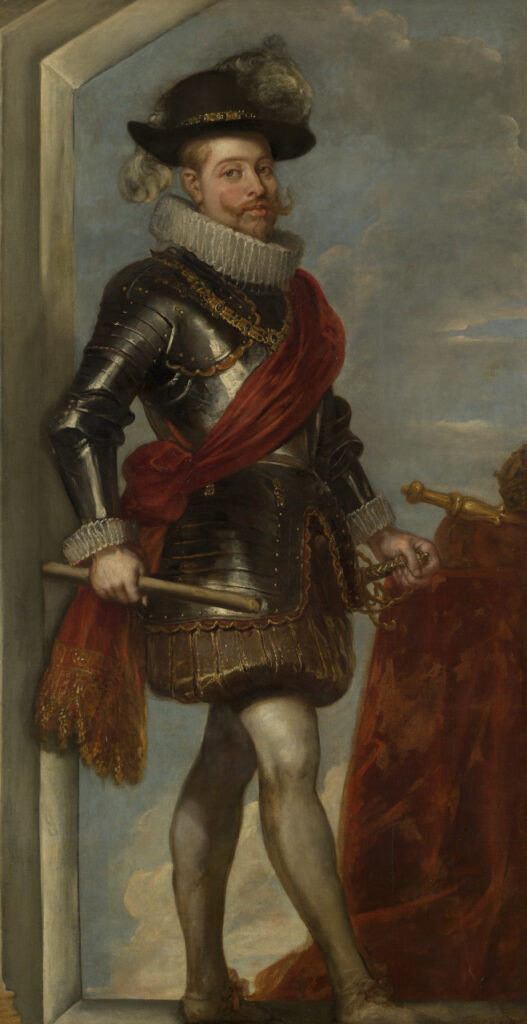King Philip III of Spain (work of art)
Artwork Info
Key Ideas
- This painted portrait depicts King Philip III of Spain. He was the King of Spain from 1598 until 1621. He ruled the Spanish Empire at the height of its power.
- The painting is part of a pair of portraits. The other one portrays King Philip IV of Spain. These paintings were originally part of a large outdoor decoration celebrating a royal entry into Antwerp, Belgium.
- Cornelis de Vos was a Flemish painter and art dealer. He was best known for painting portraits of children and families.
- The red cloth depicted in this painting would have been dyed with cochineal, a red-dye-producing insect that is similar to a beetle. This insect is native to South America and parts of North America.
- The term “cochineal” refers to the insect itself and to the vibrant red dye that comes from processing the insect.
- Cochineal was an export from the Americas that was very expensive to purchase. It was worth more per weight than sugar. The trade of cochineal made Spain very wealthy.
Learn More
This painting is a portrait of King Philip III of Spain. He was the King of Spain from 1598 until 1621. He ruled the Spanish Empire at the height of its power. The Spanish Empire was a colonial empire that controlled large portions of the Americas, Africa, various islands in Asia, and territory in other parts of Europe. By the 17th century, Spain was one of the most powerful and wealthy monarchies in the world. This was partly because of Spain’s violent colonization of the Americas. Spanish colonizers settled among and established control over Indigenous peoples and used slave labor to export large amounts of natural resources from the Americas.
King Philip III of Spain is part of a pair of portraits. The other portrait portrays King Philip IV of Spain. The portraits were originally featured on a large outdoor decoration that celebrated a royal entry into Antwerp. When de Vos painted the portraits, Antwerp was part of the Spanish Empire. The royal entry was an elaborate procession of a ruler or their representative into a city. They were greeted and honored by the city authorities. The event was usually followed by a feast and other celebrations. Decorations like these portraits were a way to demonstrate the power of the Spanish Empire.
Cornelis de Vos was a Flemish painter and art dealer during the late-16th and early-17th centuries. He was best known for his painted portraits of children and families. He often collaborated with other artists. His sister Margaretha was married to artist Frans Snyders. De Vos was one of many artists who collaborated with Peter Paul Rubens on the decorations for Torre de la Parada, a hunting pavilion owned by King Philip IV of Spain.
Red fabrics were the most expensive of fabrics in European culture. Only the wealthy, elite members of society could afford to buy them. The large amount of red cloth in this painting shows off the wealth and power of King Philip III and Spain. The red cloth depicted in this portrait would have been dyed with cochineal. This red dye comes from the cochineal, an insect that is native to South America and parts of North America. These insects are similar to beetles, and they live on certain species of cactus. In the Aztec language Nahuatl, the cochineal insects are called nocheztli, meaning “prickly pear cactus blood.” These insects were discovered, developed, and highly prized by Indigenous Americans at least 1,500 years before the arrival of Spanish colonizers.
For many years cochineal dye was expensive to purchase. It was an export from the Americas that was more valuable per weight than sugar. The dye was a major source of income for the Spanish Crown. King Philip III gave barrels of cochineal dye as gifts to foreign dignitaries and monarchies. In Europe the Spanish crown had a monopoly on cochineal until 1820, when the French learned how to cultivate the insects and produce the red dye. Eventually synthetic (human-made) alternatives to cochineal dye were created. This led to the end of the Spanish monopoly on cochineal. The dye decreased in cost and became accessible to more people.
Additional Resources
Resources for Teachers
- Read a biography about King Philip III of Spain.
- Read a biography about Cornelis de Vos.
- View a lesson plan about the Spanish colonization of the Americas.
- View a drawing from 1620 depicting the cultivation of cochineal.
Resources for Students
- View another portrait by Cornelis de Vos.
- Watch a video about the history of cochineal.
- Watch a video about the cochineal insect.
Images
-

King Philip III of Spain
An oil painting of a man. The man is standing with his right leg pointed out in front of him, next to a table covered in red fabric. Part of a golden scepter and crown are visible on the table. The man is wearing dark gray armor over his clothing. The armor covers his arms and chest, and ends just below his hips. He is wearing puffy breeches or shorts, white stockings, and a white pleated collar around his neck and wrists. There is a red sash tied across his chest. The end of the sash features gold embroidery. The man’s left hand rests on the top of a sword that hangs from his hip, and he is holding a stick-shaped object in his right hand. He is wearing a large black hat with a white feather on his head. He has a mustache that sticks out and curls up at the sides, and he has a goatee on his chin. The backdrop behind the man features a blue sky filled with white clouds.
